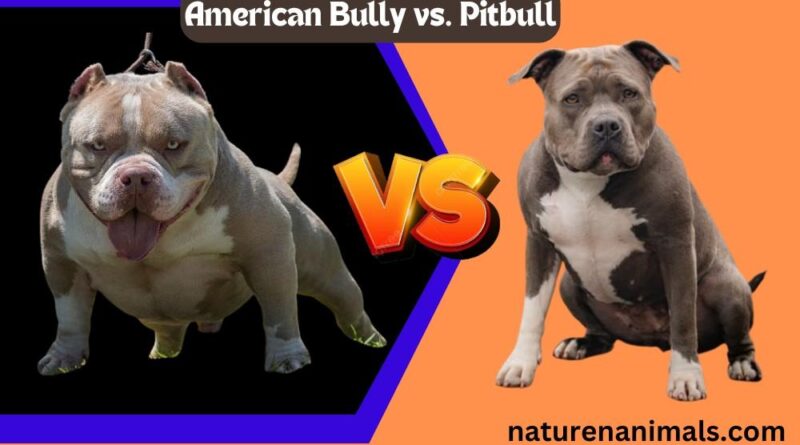American Bully vs. Pitbull: What’s the Difference?
Today, dog lovers often find themselves face-to-face with the debate between the American Bully and the Pitbull. Both breeds share a rich history and distinct characteristics, yet they’re often confused. So, what sets them apart? Understanding these differences lies in diving into their origins, physical traits, temperaments, and training needs.
1. History and Origins
The journey of these breeds spans centuries, revealing fascinating stories of evolution and purpose.
1.1 Origins of the Pitbull
Pitbulls trace their roots back to 19th century England, where they were born from a mix of Bulldogs and Terriers. Originally bred for bull-baiting and dogfighting, these dogs combined the strength of Bulldogs with the tenacity of Terriers. Despite their tough origins, responsible breeding has transformed them into loyal, family-oriented pets.
1.2 Creation of the American Bully
In contrast, the American Bully is a relatively new breed, emerging in the late 20th century. Developed in the United States from American Pitbull Terriers, American Staffordshire Terriers, and other bulldog breeds, the American Bully was intended to create a dog with a more companionable temperament. Unlike the Pitbull’s work-oriented past, the American Bully was bred to be a charming, family-favorite companion.
2. Physical Characteristics
When comparing the American Bully to the Pitbull, their physical differences are quite telling.
2.1 Size and Build
Pitbulls are typically medium-sized, muscular, and lean. They have a well-proportioned body and can weigh between 30 to 60 pounds. Their athletic physique is matched by an eager expression that seems to say, “Let’s play!”
On the other hand, American Bullies are more diverse in their size. They range from pocket-sized to XL, with a more stocky and robust build. Strong bones and a broad chest lend the American Bully a commanding presence. They often weigh from 70 to 120 pounds, showcasing sheer power.
2.2 Coat Colors and Patterns
Both breeds boast an array of coat colors and patterns. Pitbulls often display a smooth, short coat in various colors like brindle, fawn, white, and black. Their distinctive markings can make each dog unique.
The American Bully takes color diversity to another level. You can find blue, tri-color, merle, and even champagne hues. Their glossy, shiny coat is a testament to their well-cared-for lifestyle, making them stand out at any dog park.
3. Temperament and Behavior
A breed’s temperament can seal the deal when choosing a family pet. Let’s see how these two compare.
3.1 Personality Traits of the Pitbull
Pitbulls are renowned for their undying loyalty and perseverance. They’re often misunderstood due to their past, yet true Pitbull enthusiasts know them as affectionate and eager to please. Their high energy levels mean they’re always ready for a run or play session, and they thrive on human interaction. Desiring consistent companionship, they can sometimes suffer from separation anxiety.
3.2 Temperament of the American Bully
American Bullies are known for their calm, gentle nature. While they maintain an assertive appearance, don’t let it mislead you. They are social butterflies who love human attention and are incredibly tolerant — especially towards children. Their mellow disposition layered with confidence makes them ideal for families.
4. Training and Socialization
Tailoring training to suit each breed ensures a happier, well-adjusted pet.
4.1 Training Pitbulls
Pitbulls’ intelligence and eagerness make them highly trainable. Positive reinforcement works wonders, tapping into their excitement for praise and treats. It’s crucial for them to burn off energy with daily exercise, as a bored Pitbull can be destructive. Begin socializing them from a young age to help them be comfortable with other pets and people.
4.2 Training American Bullies
American Bullies, though more laid-back, still benefit greatly from structured training. They’re known to respond well to consistency and patience. Focus on command training and obedience, reinforcing positive behavior with rewards. Their sociable nature means they often enjoy meeting new friends — both human and canine.
5. Health Considerations
Both breeds are generally healthy, but they have their share of genetic considerations.
5.1 Health Issues in Pitbulls
Pitbulls might face hip dysplasia, skin allergies, and heart disease. Routine vet visits and maintaining a balanced diet can mitigate these concerns. Their active lifestyle also demands joint health supplements to sustain their energy levels.
5.2 Health Issues in American Bullies
American Bullies can be prone to similar issues, including hip dysplasia and heart disease. Obesity is another concern due to their stocky build, so keeping them on a proper diet and exercise regimen is crucial. Regular vet screenings help in early detection of any potential health issues.
6. Conclusion
Despite occasional confusion between the American Bully and the Pitbull, their differences are evident upon closer observation. From their origins to their physical and temperament traits, each breed offers something unique. Choosing between these lovable dogs should be based on lifestyle compatibility, understanding their needs, and responsible ownership. Both breeds, when given love and proper care, thrive as loyal family companions. Make your choice responsibly, ensuring your four-legged friend receives the best life possible.



